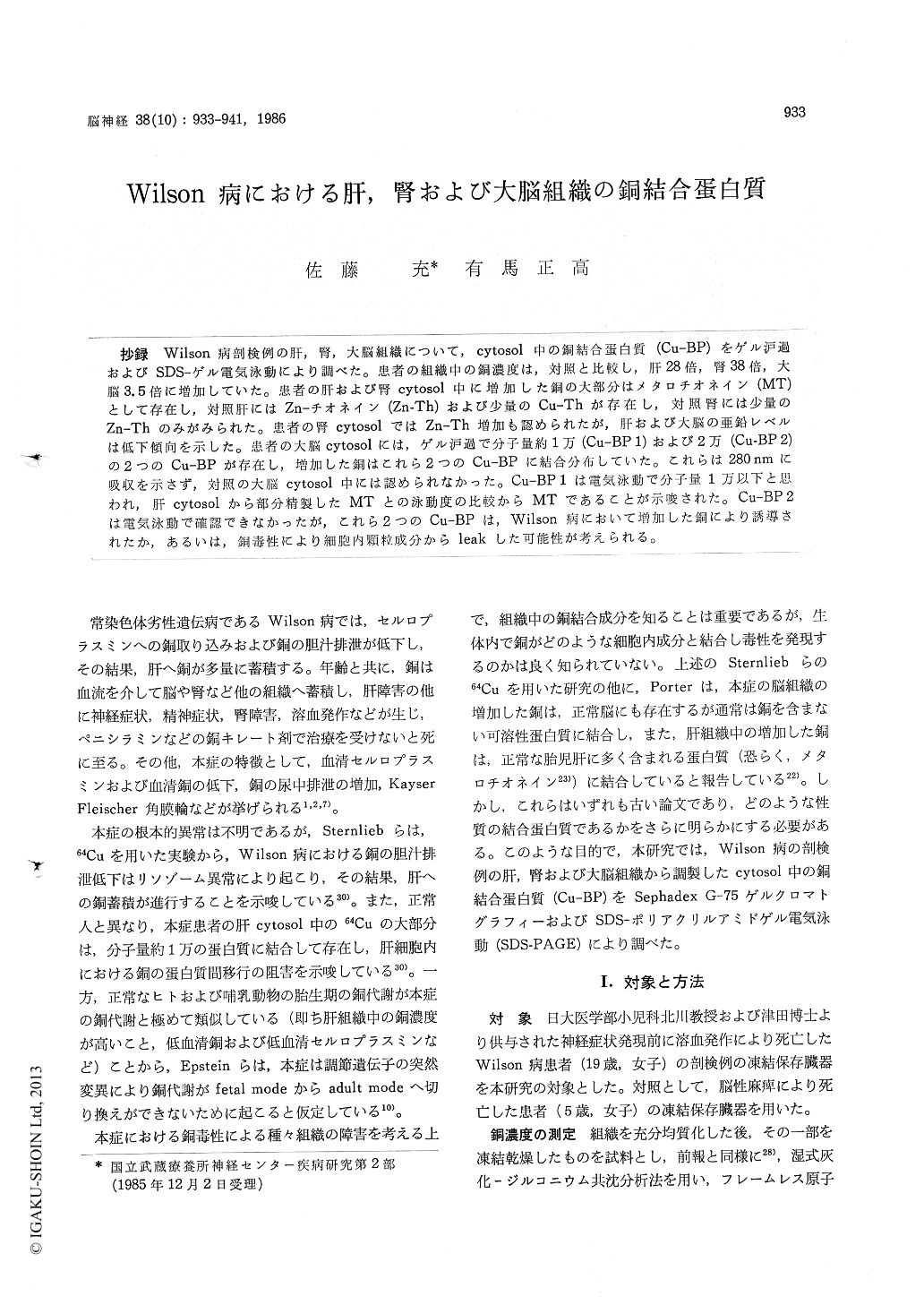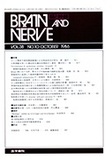Japanese
English
- 有料閲覧
- Abstract 文献概要
- 1ページ目 Look Inside
抄録 Wilson病剖検例の肝,腎,大脳組織について,cytosol中の銅結合蛋白質(Cu-BP)をゲル炉過およびSDS-ゲル電気泳動により調べた。患者の組織中の銅濃度は,対照と比較し,肝28倍,腎38倍,大脳3.5倍に増加していた。患者の肝および腎cytosol中に増加した銅の大部分はメタロチオネイン(MT)として存在し,対照肝にはZn-チオネイン(Zn-Th)および少量のCu-Thが存在し,対照腎には少量のZn-Thのみがみられた。患者の腎cytosolではZn-Th増加も認められたが,肝および大脳の亜鉛レベルは低下傾向を示した。患者の大脳cytosolには,ゲル炉過で分子量約1万(Cu-BP 1)および2万(Cu-BP 2)の2つのCu-BPが存在し,増加した銅はこれら2つのCu-BPに結合分布していた。これらは280nmに吸収を示さず,対照の大脳cytosol中には認められなかった。Cu-BP 1は電気泳動で分子量1万以下と思われ,肝cytosolから部分精製したMTとの泳動度の比較からMTであることが示唆された。Cu-BP 2は電気泳動で確認できなかったが,これら2つのCu-BPは,Wilson病において増加した銅により誘導されたか,あるいは,銅毒性により細胞内顆粒成分からleakした可能性が考えられる。
Copper-binding proteins (Cu-BPs) in the liver, kidney, and brain tissues from a Wilson's disease patient, who was 19-year-old woman and died of he-molytic crisis, were examined with Sephadex G-75 gel chromatography and SDS-polyacrylamide gel electrophoresis (SDS-PAGE). Copper contents, which were determined by flameless atomic absorp-tion spectrophotometry in the liver, kidney, and cerebral tissues from the patient, were 28-,38-,and 3. 5-fold, respectively, as compared to those of control subject, who was 5-year-old girl and died of cerebral palsy.
Each tissue was homogenized in 3 volumes of 50 mM Tris-HC1 buffer, pH 8. 6, and the homoge-nate was centrifuged at 105,000 g for 60 min to obtain cytosol fraction. Sephadex G-75 gel chro-matography of cytosols from Wilson's liver and kidney showed that most of increased copper ex-isted as Cu-thionein (Cu-Th), in contrast to a much lower Cu-Th level in control liver cytosol and to no detectable amount of Cu-Th in control kidney cytosol. In addition, Zn-Th was also increased in Wilson's kidney cytosol, while it was decreased in Wilson's liver cytosol.
Gel chromatography of Wilson's cerebral cytosol revealed that the increased copper bound mainly to two proteins with apparent molecular mass of 10 kDa (Cu-BP 1) and 20 kDa (Cu-BP 2), respect-ively, both of which showed no absorption at 280nm and were not observed in control cerebral cytosol even after addition of excess copper (50 μg/ml) as CuSO4. These results suggest that two Cu-BPs were induced by the increased copper in Wilson's cerebrum, or leaked by copper toxicity from in-tracellular particulate components such as synapto-somes, mitochondria, or lysosomes, and that they have similar properties to metallothionein (MT,Cu-Th).
Then, we examined by SDS-PAGE as to whether or not two Cu-BPs seen in Wilson's cerebrum were identical with metallothionein, namely Cu-Th seen in the liver and kidney tissues. Liver Cd-Th was partially purified as follows ; Excess amount of cadmium (45μg Cd/ml) as CdCl2 was added to Wilson's liver homogenate to convert Cu-Th into Cd-Th. After heat-treatment at 90℃ for 5 min, the homogenate was centrifuged at 105, 000 g for 60 min to obtain crude metallothionein fraction as supernatant. Cd-Th is known to remain to be soluble after the heat-treatment. The supernatantwas chromatographed on Sephadex G-75 column to obtain partially purified Cd-Th. After dialysis and lyophilization of the pooled Cd-Th fractions, the partially purified Cd-Th was electrophoresed with 7.5% slab gel, according to the Laemmli's me-thod15), and proteins were stained with Coomassie brilliant blue R 250. The partially purified Cd-Th exhibited a major protein band with apparent mole-cular mass below 10 kDa and similar protein band was seen in Cu-BP 1 fractions from Wilson's cerebral cytosol but not in corresponding fractions from control cytosol. These results indicate that Cu-BP 1 is similar in chromatographic and electro-phoretic behaviors to hepatic metallothionein, al-though further characterization is necessary to identify it. Whereas, Cu-BP 2 was not able to be clarified by SDS-PAGE.
It is possible that these Cu-BPs observed in Wilson's cerebrum involve in copper accumulation or in protection of brain cells against copper to-xicity. Therefore, further identification of these Cu-BP and confirmation as to whether or not they exist in brain tissue of other Wilson's disease patients require further study.

Copyright © 1986, Igaku-Shoin Ltd. All rights reserved.


